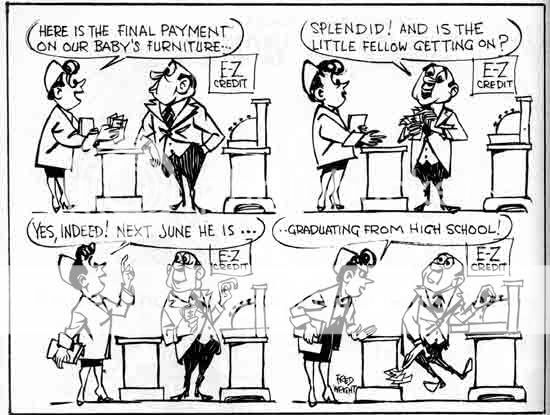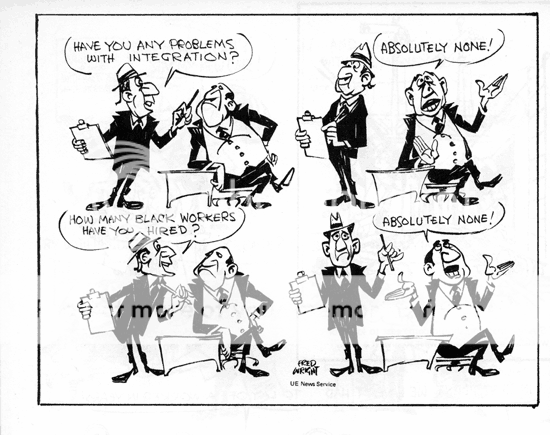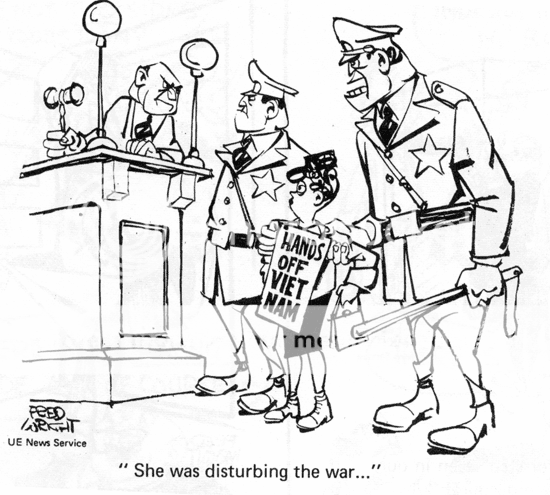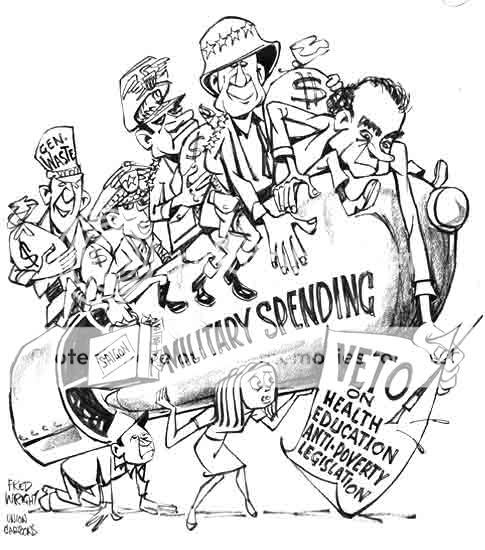Fred Wright: Labor Laffs for the Working Class
“There is a thin line that separates laughter and pain, comedy and tragedy, humor and hurt.” ― Erma Bombeck
Labor cartoonist Fred Wright was a radical artist who walked that thin line in a way that would impress any circus tightrope walker. The son of working class parents, Fred Wright knew the world of class warfare up-close and personal when he first began cartooning for the National Maritime Union (NMU) in 1939. He became staff cartoonist for the United Electrical, Radio and Machine Workers of America (UE) in 1949, a job he held until the early 1980’s.
Layoffs, industrial accidents, harassment of all types, discrimination, poverty wages, union-busting, exposure to mean bosses and other human tragedies were the basis for his humor.
Poet and playwright Bertolt Brecht once said,”The man who laughs has not yet heard the terrible news.” Fred Wright was used to hearing terrible news. It was all around him. And like Brecht, Wright understood how tragedy can be the basis of humor; humor that can help people laugh in the face of adversity and then if possible, organize and try to prevent the same tragedies from happening again.
Former UE General President A.J. Fitzgerald described Wright’s work with these words:
“His cartoons have been a powerful weapon in the union’s organizing campaigns, grievances and strikes. The powerful thrusts of his prolific pen played a major role in the UE’s struggle against the vicious political attacks of the infamous McCarthy period.”
The UE was born in the trenches of class warfare in 1936. The owners of the gigantic industrial facilities of the time ran their machines at a near-impossible inhuman pace. Workplace deaths and injuries were frequent. The supervisors acted like brutal prison guards in a Hollywood film. Pay was low. Worker anger was high.
The huge electronics companies like GE, Westinghouse and Emerson were run as totalitarian dictatorships in what was supposed to be an American democracy. This was considered to be a capitalist “freedom”, a mangling of the English language that is beyond mere hypocrisy.
It was an American Petrograd and it didn’t take many labor radicals to help lead the massive working class revolts that shook Depression Era USA. The owners fought back with guns, tear gas bombs, beatings and mass arrests. Blood ran in the streets. Literally. Then labor organizers discovered the sit-down strike which dramatically increased the power of the working class. For what owner was eager to storm their own factory and risk destruction of their precious capital investment?

The UE led Emerson sit-down strike lasted 53 days in 1937.
It was one of the longest sit-down strikes in US history
UE members were among the many American workers who courageously sat down during the wave of sit-down strikes that accompanied the founding of the Congress of Industrial Organizations (CIO), that great American experiment in social justice unionism.
UE had a strong commitment to internal education of its members and later commissioned Fred Wright and writer James Lerner to produce an illustrated labor history series. Below is a panel celebrating the union’s founding:

Wright’s cartoons were based on the daily routines experienced by the men and women on the shop floor, when the shop floor was not the rare experience that it is today in the wake of American deindustrialization. Wright understood that capitalism eats away at peoples’ self-confidence and self-respect by a constant barrage of seemingly small slights and insults.
The idea is to wear people down, causing them to retreat into non-resistance or better yet, side with the bosses and join in with the American capitalist culture of racial and gender discrimination. Wright’s shop floor cartoons had a universal working class appeal because people were also treated poorly in non-industrial jobs, even if the work pace and the dangers were not as severe.
Wright was acutely aware that working class people have lives outside of the workplace and you will find his characters shopping, vacationing, at the doctor’s office, at home with their families, protesting with picket signs and in court with those same picket signs, sometimes showing evidence of rough treatment at the hands of police.
His working class characters were not one dimensional. He portrayed them as reacting to working class life in a number of ways: shock, anger, confusion, amusement, resignation, defiance and joy.
Even his villains display emotion in a variety of ways, rather than the same tedious expression of pure evil one often sees in left-wing cartoons.
Wright’s portrayal of class war shares some similarities with the way World War II was drawn by the great liberal cartoonist of the same period, Bill Mauldin. Mauldin’s GI characters Willie and Joe found no glory in war but made the best of it through small acts of resistance and a dry sense of irony.
From the Post-WWII Red Scare to the youth revolt of the 1960’s and 1970’s.
“The problems of the United States can be summed up in two words: Russia abroad, labor at home.” –Charles E. Wilson, President of General Electric 1946.
By the end of World War II UE had 600,000 members and was the third largest CIO union in the nation.
The Red Scare hit almost immediately after WWII ended. The largest and most influential US corporations wanted to prevent the expansion of any New Deal social legislation such as national health insurance, public housing or aid to education. They wanted to keep unions out of the segregated American South where Jim Crow racial divisions kept wages low and profits high.
They wanted a military confrontation with the Soviet Union. They wanted to defeat, or at least contain soviet-style communism, not because of its undemocratic nature; US corporations regularly allied with rightwing dictators, but because it threatened their profits. The Cold War was on.
The communists, socialists, labor radicals and progressive Democrats who had been so important in organizing the CIO became a target of government persecution and attacks by right-wing unions. The UE had communists in its leadership which made it a prime target

It lost most of its members to the rival International Union of Electrical Workers (IUE) in a civil war within the labor movement that destroyed much of the radical social justice traditions of the CIO.
Cold War? Class War? A perfect time for more labor cartoons
Fred Wright joined the UE in 1949 when the Cold War Red Scare was already taking its toll. Besides the loss in membership, UE leaders like James Matles, Tom Quinn and Julius Emspak were the victims of McCarthyite persecution, forced to appear in front of government committees and ordered to name the communists within the their union. There were attacks on pro-UE workers in the plants. It was a time that pitted neighbor against neighbor and split families.
<
The big companies used the Red Scare to try and slash wages and benefits. This did not always work and there were workers from other unions who came to the aid of UE strikers and citizens of all social classes who stood up to the red-baiters. What better time for a counter-attack using hard-hitting cartoons? They were good for UE member morale. They were good for counteracting the pall of fear that had fallen across America.
Fred Wright refused to be intimidated and continued to turn out his own brand of working class humor.
As Gary Huck, who succeeded Fred Wright as UE cartoonist points out:
“Wright was one of the first cartoonists in America to introduce more of a cartoony style to political cartoons and place a big emphasis on humor, keeping in mind that none of the politics are diminished.”
The 1950’s was a golden age for magazine cartooning and if Wright had been willing to denounce his political beliefs, inform on his friends and use his cartoon wit for acceptable subjects, he probably could have made a pretty decent living in mainstream publications.
The Red Scare began to abate in the early 1960’s, mostly because the spirit of revolt ignited by the civil rights movement. The UE had always taken a strong stand against racial and gender discrimination and many of Wright’s cartoons reflected these concerns. The UE was also of the first unions to come out against the Vietnam War.
The youth revolt of the 1960’s on the campuses and in the workplace gave rise to a lively underground press. There were also radical rank and file union newsletters that challenged not only the bosses, but the conservative union leadership.
Wright’s cartoons found their way to a whole new audience. In addition the illustrated labor history panels that he and Jim Learner did for UE News were also republished. The work was shamelessly “lifted” for free by young editors working on a financial shoestring, but Wright didn’t mind because it was the issues that were important.
I never actually met Fred Wright although once I came close. In 1981 the UE local at the North Side Chicago Stewart-Warner auto parts plant went on strike. After the strike,I ran into my friend Jim, a UE steward. I asked him about the strike and he told me that Fred Wright had been sent to Chicago to help out by drawing cartoons. He described Wright as low-keyed and personable.
Then realizing that my partner Estelle and I had recently gotten into cartooning, he looked at me in an embarrassed way and said,” I guess I should have introduced you.” I was disappointed, but not upset with Jim. His job during the walkout was to issue strike benefits according to need, a difficult and often thankless job. He had a lot on his mind.
The Stewart-Warner plant later closed in the mass deindustrialization of the Reagan Age and both Fred Wright and Jim died just a few years after Wright’s visit to Chicago.
Today with the stirrings of a new labor revolt in the Fight for $15 movement and the neo-liberal attack on anything beneficial to the working class, I think it’s time to revisit and republish the cartoons of Fred Wright. He was incredibly prolific and though some of his work has been superseded by events, many of his cartoons are all too relevant today.
What’s old is new again…
Bob “BobboSphere” Simpson and Estelle Carol make up the labor cartoon team Carol Simpson. They are currently on leave but did labor cartooning for over 25 years and have been published in labor, alternative, educational and mainstream publications across North America. They count Fred Wright as a major influence.
This article first appeared in Red Wedge Magazine
Sources consulted
So Long, Partner by Fred Wright
Labor Cartoons: Drawing on Worker Culture by Mike Konopacki and Gary Huck
Drawing on the American Labor Movement University of Pittsburg Library
Radical Cartooning in the Labor Movement as History by Gary Huck (video)
Sit-down strike at Emerson was one of nation’s longest by Tim O’Neil
Them and Us: Struggles of a Rank and File Union by James Matles and James Higgins















